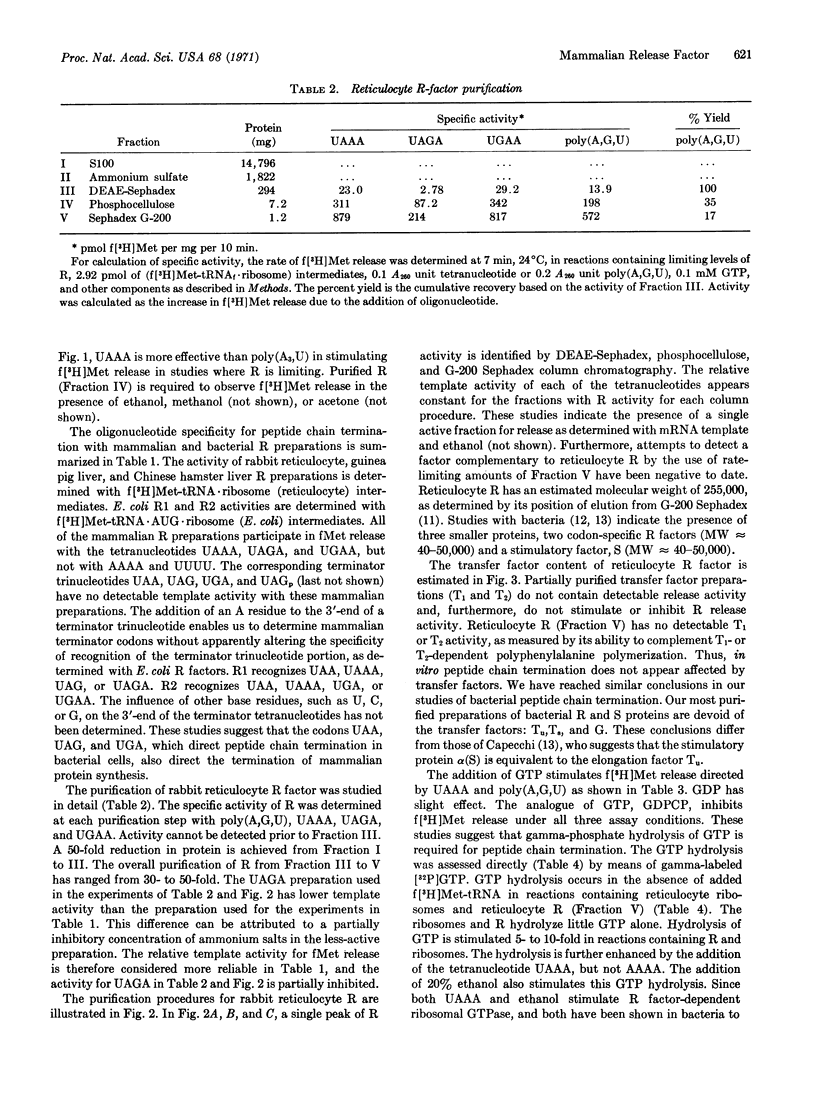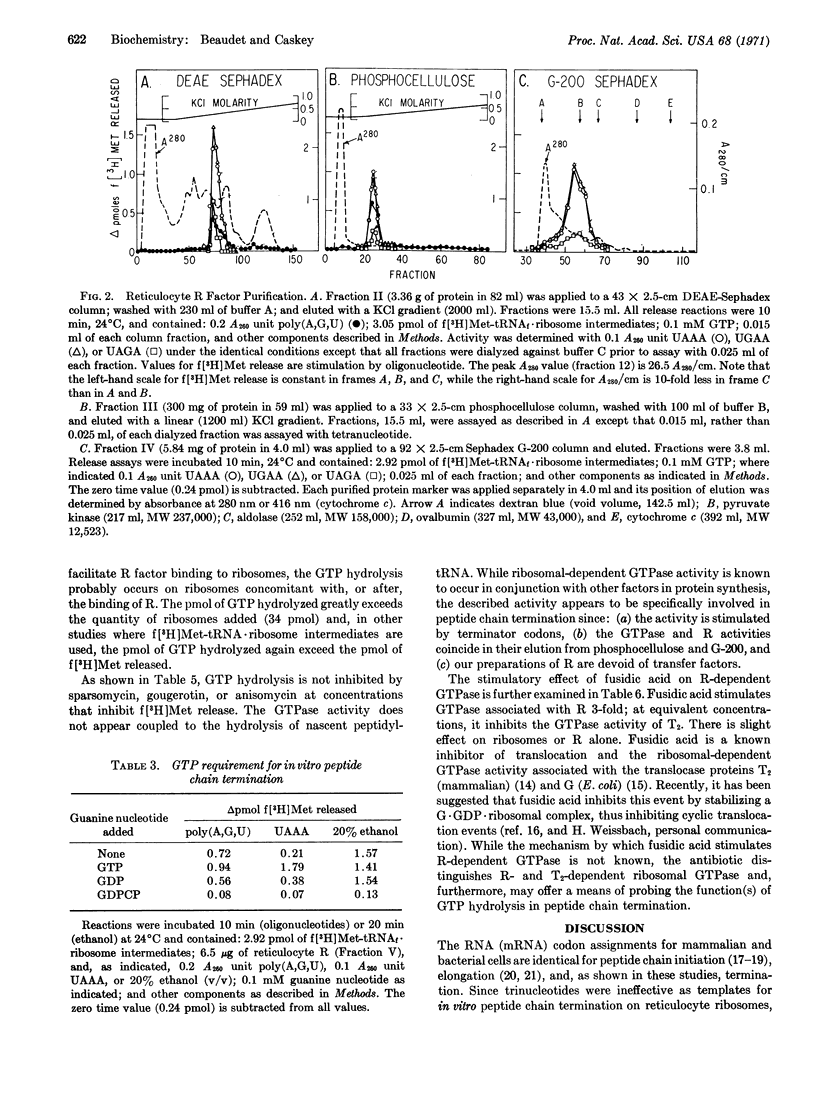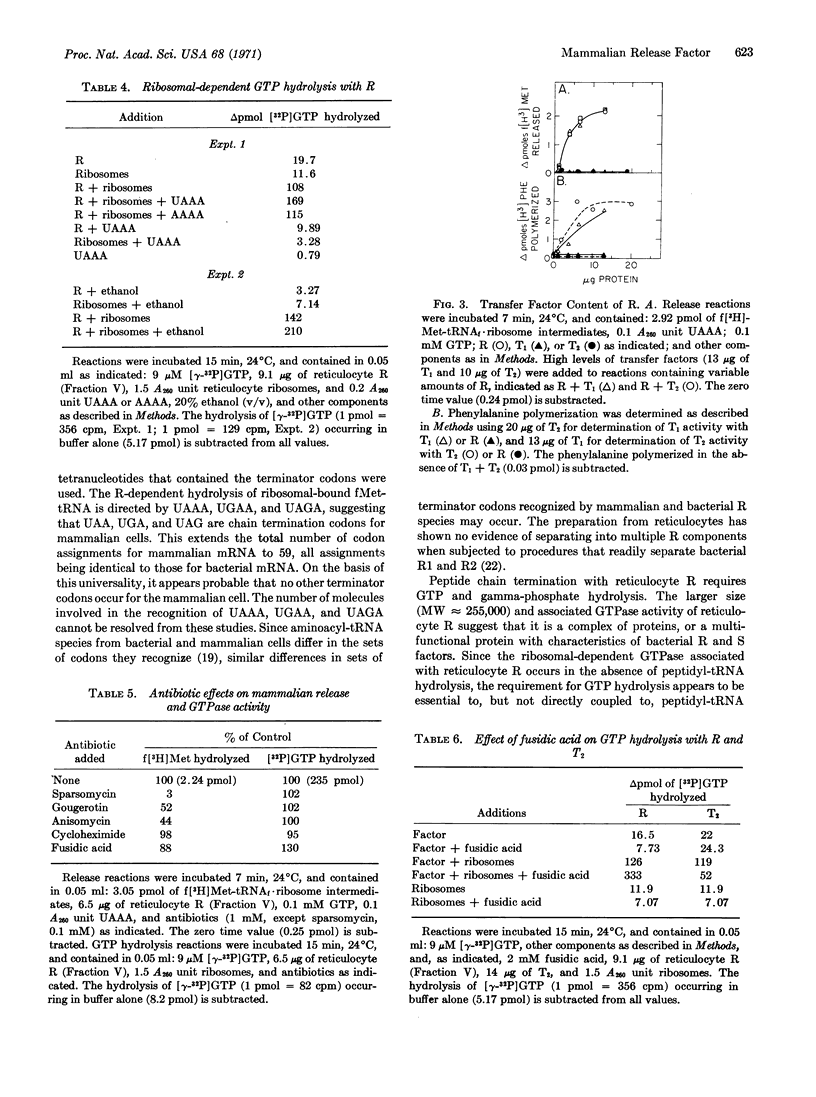Abstract
In vitro peptide chain termination with release factor preparations from rabbit reticulocytes, guinea pig liver, or Chinese hamster liver is directed with UAAA, UAGA, or UGAA, suggesting that UAA, UAG, and UGA are terminator condons for mammalian cells. Purified release factor from rabbit reticulocytes has ribosomaldependent GTPase activity, which is stimulated by UAAA. GTP hydrolysis appears requisite for in vitro peptide chain termination in mammals.
Full text
PDF





Selected References
These references are in PubMed. This may not be the complete list of references from this article.
- Andrews P. Estimation of the molecular weights of proteins by Sephadex gel-filtration. Biochem J. 1964 May;91(2):222–233. doi: 10.1042/bj0910222. [DOI] [PMC free article] [PubMed] [Google Scholar]
- Bodley J. W., Zieve F. J., Lin L., Zieve S. T. Studies on translocation. 3. Conditions necessary for the formation and detection of a stable ribosome-G factor-guanosine diphosphate complex in the presence of fusidic acid. J Biol Chem. 1970 Nov 10;245(21):5656–5661. [PubMed] [Google Scholar]
- Brown J. C., Smith A. E. Initiator codons in eukaryotes. Nature. 1970 May 16;226(5246):610–612. doi: 10.1038/226610a0. [DOI] [PubMed] [Google Scholar]
- Capecchi M. R., Klein H. A. Characterization of three proteins involved in polypeptide chain termination. Cold Spring Harb Symp Quant Biol. 1969;34:469–477. doi: 10.1101/sqb.1969.034.01.053. [DOI] [PubMed] [Google Scholar]
- Caskey C. T., Beaudet A., Nirenberg M. RNA codons and protein synthesis. 15. Dissimilar responses of mammalian and bacterial transfer RNA fractions to messenger RNA codons. J Mol Biol. 1968 Oct 14;37(1):99–118. doi: 10.1016/0022-2836(68)90076-4. [DOI] [PubMed] [Google Scholar]
- Caskey C. T., Tompkins R., Scolnick E., Caryk T., Nirenberg M. Sequential translation of trinucleotide codons for the initiation and termination of protein synthesis. Science. 1968 Oct 4;162(3849):135–138. doi: 10.1126/science.162.3849.135. [DOI] [PubMed] [Google Scholar]
- Caskey T., Scolnick E., Tompkins R., Goldstein J., Milman G. Peptide chain termination, codon, protein factor, and ribosomal requirements. Cold Spring Harb Symp Quant Biol. 1969;34:479–488. doi: 10.1101/sqb.1969.034.01.054. [DOI] [PubMed] [Google Scholar]
- Glynn I. M., Chappell J. B. A simple method for the preparation of 32-P-labelled adenosine triphosphate of high specific activity. Biochem J. 1964 Jan;90(1):147–149. doi: 10.1042/bj0900147. [DOI] [PMC free article] [PubMed] [Google Scholar]
- Goldstein J. L., Beaudet A. L., Caskey C. T. Peptide chain termination with mammalian release factor. Proc Natl Acad Sci U S A. 1970 Sep;67(1):99–106. doi: 10.1073/pnas.67.1.99. [DOI] [PMC free article] [PubMed] [Google Scholar]
- Goldstein J. L., Caskey C. T. Peptide chain termination: effect of protein S on ribosomal binding of release factors. Proc Natl Acad Sci U S A. 1970 Oct;67(2):537–543. doi: 10.1073/pnas.67.2.537. [DOI] [PMC free article] [PubMed] [Google Scholar]
- Gupta N. K. Studies on polynucleotides. LXXXIX. A study of amino acid incorporation in a reticulocyte cell-free protein-synthesizing system with polyribonucleotides with repeating nucleotide sequences used as messengers. J Biol Chem. 1968 Oct 10;243(19):4959–4965. [PubMed] [Google Scholar]
- Haenni A. L., Lucas-Lenard J. Stepwise synthesis of a tripeptide. Proc Natl Acad Sci U S A. 1968 Dec;61(4):1363–1369. doi: 10.1073/pnas.61.4.1363. [DOI] [PMC free article] [PubMed] [Google Scholar]
- Kinoshita T., Kawano G., Tanaka N. Association of fusidic acid sensitivity with G factor in a protein-synthesizing system. Biochem Biophys Res Commun. 1968 Dec 9;33(5):769–773. doi: 10.1016/0006-291x(68)90226-x. [DOI] [PubMed] [Google Scholar]
- Kolakofsky D., Dewey K. F., Hershey J. W., Thach R. E. Guanosine 5'-triphosphatase activity of initiation factor f2. Proc Natl Acad Sci U S A. 1968 Nov;61(3):1066–1070. doi: 10.1073/pnas.61.3.1066. [DOI] [PMC free article] [PubMed] [Google Scholar]
- LOWRY O. H., ROSEBROUGH N. J., FARR A. L., RANDALL R. J. Protein measurement with the Folin phenol reagent. J Biol Chem. 1951 Nov;193(1):265–275. [PubMed] [Google Scholar]
- Leder P., Singer M. F., Brimacombe R. L. Synthesis of trinucleoside diphosphates with polynucleotide phosphorylase. Biochemistry. 1965 Aug;4(8):1561–1567. doi: 10.1021/bi00884a015. [DOI] [PubMed] [Google Scholar]
- Malkin M., Lipmann F. Fusidic acid: inhibition of factor T2 in reticulocyte protein synthesis. Science. 1969 Apr 4;164(3875):71–72. doi: 10.1126/science.164.3875.71. [DOI] [PubMed] [Google Scholar]
- Marshall R. E., Caskey C. T., Nirenberg M. Fine structure of RNA codewords recognized by bacterial, amphibian, and mammalian transfer RNA. Science. 1967 Feb 17;155(3764):820–826. doi: 10.1126/science.155.3764.820. [DOI] [PubMed] [Google Scholar]
- NIRENBERG M. W., MATTHAEI J. H. The dependence of cell-free protein synthesis in E. coli upon naturally occurring or synthetic polyribonucleotides. Proc Natl Acad Sci U S A. 1961 Oct 15;47:1588–1602. doi: 10.1073/pnas.47.10.1588. [DOI] [PMC free article] [PubMed] [Google Scholar]
- Ohta T., Sarkar S., Thach R. E. The role of guanosine 5'-triphosphate in the initiation of peptide synthesis. 3. Binding of formylmethionyl-tRNA to ribosomes. Proc Natl Acad Sci U S A. 1967 Oct;58(4):1638–1644. doi: 10.1073/pnas.58.4.1638. [DOI] [PMC free article] [PubMed] [Google Scholar]
- Ravel J. M. Demonstration of a guanosine triphosphate-dependent enzymatic binding of aminoacyl-ribonucleic acid to Escherichia coli ribosomes. Proc Natl Acad Sci U S A. 1967 Jun;57(6):1811–1816. doi: 10.1073/pnas.57.6.1811. [DOI] [PMC free article] [PubMed] [Google Scholar]
- Scolnick E., Tompkins R., Caskey T., Nirenberg M. Release factors differing in specificity for terminator codons. Proc Natl Acad Sci U S A. 1968 Oct;61(2):768–774. doi: 10.1073/pnas.61.2.768. [DOI] [PMC free article] [PubMed] [Google Scholar]
- Smith A. E., Marcker K. A. Cytoplasmic methionine transfer RNAs from eukaryotes. Nature. 1970 May 16;226(5246):607–610. doi: 10.1038/226607a0. [DOI] [PubMed] [Google Scholar]


